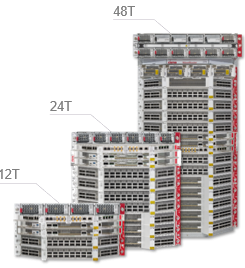-
Ciena expanded its WaveRouter offering with 12 Tbps and 24 Tbps metro routers
-
The company introduced its 48 Tbps WaveRouter platform last year, and is now giving service providers more options with managing their metro networks
-
Analyst Ray Mota said WaveRouter has positioned Ciena as "a strong competitor” in the metro routing space
Connectivity is everything in the big city, and operators must contend with a volume of network traffic. Ciena’s trying to make it a little easier for them with the expansion of its WaveRouter product line.
Ciena unveiled the WaveRouter platform for metro networks last year. Then the solution came with 13-slot housing and up to 48 Tbps of capacity. Now, it’s releasing two new iterations of WaveRouter – a two-slot and a seven-slot form factor with 12 Tbps and 24 Tbps of capacity, respectively.

Gina Nienaber, senior director of product marketing at Ciena, said the new products are really about providing more choices to customers for converging their metro networks as well as expand market penetration for the WaveRouter overall.
WaveRouter is scalable from 6 Tbps to 192 Tbps in 6 Tbps increments. What that means is that a customer can start with say, a 48 Tbps metro router and then add either an identical one, the 12 Tbps or the 24 Tbps router on top of it, and go all the way up to 192 Tbps.
“You can start with one housing. And then you can add a second housing into a single rack. And then you can continue like Lego blocks to chain them together,” said Nienaber.
She added the additional form factors can be on an adjacent rack or row, “not even right next to each other.”
Like Ciena’s first version of WaveRouter, the two-slot and seven-slot form factors also offer multi-layer domain control and visibility across Layers 0,1,2 and 3 of a network.
WaveRouter is targeted at communications service providers, Nienaber said, like cable multi-service operators (MSOs) and others with “large networks and high-bandwidth needs.” Verizon is one company that’s publicly endorsed the WaveRouter platform, she noted.
Large tier-one service providers might focus on the WaveRouter-13, whereas for smaller tier two and tier three providers, the 24 Tbps WaveRouter “might be enough.” The smaller form factors are also flexible for international service providers who may not need the 48 Tbps capacity for their markets, according to Nienaber.
“WaveRouter 2 and 7 for instance might be really suited for the international communications service providers to service things like enterprise, residential, mobile, wholesale, things like converged infrastructure for aggregation and metro use cases,” she explained. “It’s pretty vast you know – you could service the IP edge, submarine use cases.”
Where's the beef?
In beefing up the WaveRouter portfolio, Ciena aimed to address some of the challenges operators face in traversing a metropolitan area network.
One challenge is the “unprecedented traffic demand driven by the exponential growth of broadband, 5G and cloud-based applications," said Nienaber. She also pointed out that for years, operators have been using “fragmented and time-consuming operational tools” to manage both IP and optical networks.
Furthermore, “surging costs” for things like increased space, energy and cooling (as a result of more bandwidth demand) are “defeating [operators’] sustainability aspirations.”
She said providers right now are looking at their existing metro routing platforms and are concerned about not meeting that demand.
“That’s why they’re forced to sacrifice in areas of scalability or operational simplicity and sustainability, and they are at that tipping point where they’re trying to decide if they want to continue to pay the cost or do they want to converge where they can,” Nienaber said. “WaveRouter was designed for this moment.”
Ciena's metro routing muscle
With WaveRouter, Ciena’s positioned itself as a “strong competitor” in the metro routing space, according to Ray Mota, CEO and principal analyst at ACG Research.
Cisco, Nokia and Juniper Networks are also players in the space, but unlike the offerings from those companies, “Ciena's coherent routing strategy and the unified IP-optical-compute platform differentiate it by offering enhanced network efficiency, simplified operations, and future-proof scalability,” Mota told Fierce.
Basically, it comes back to convergence, he said.
“This integrated approach may provide Ciena with a competitive edge in addressing the complex requirements of modern metro networks,” he said.
Mota also pointed out service providers’ need for extra terabit capacity “cannot be understated,” especially as global internet traffic continues to grow through video streaming, cloud computing and IoT devices.
The scalability of the WaveRouter series is “crucial not only for handling current traffic volumes but also for future-proofing networks against the rapidly increasing demands of next-generation applications, including 5G services, ultra-high-definition content, and emerging technologies like VR and AR,” he added.
